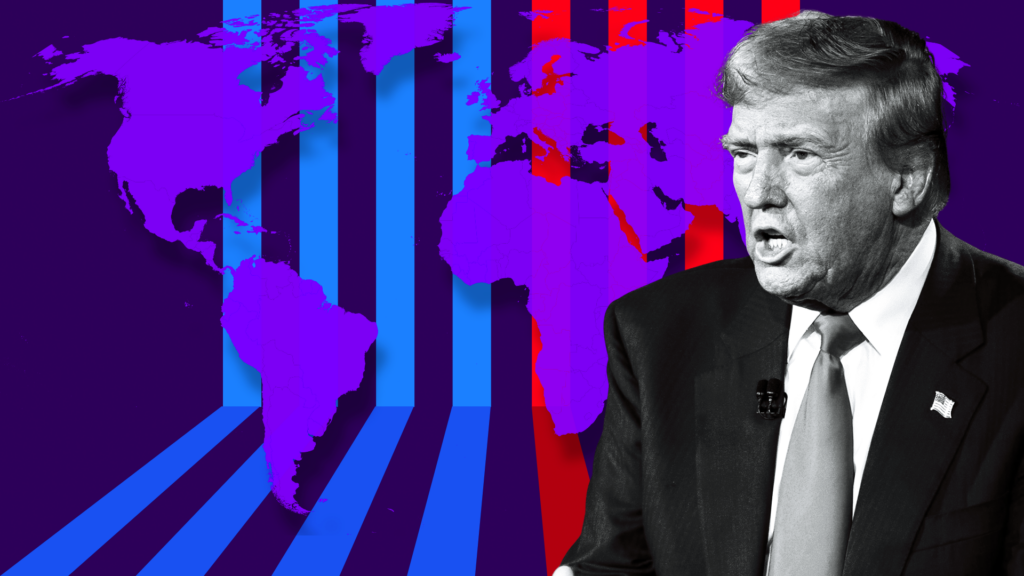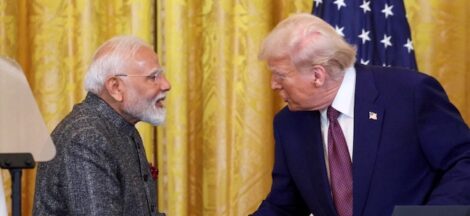By C.J. Atkins
WASHINGTON: He’s hot, then he’s cold. He’s yes, then he’s no. He’s in, then he’s out. He’s up, then he’s down. Donald Trump appears to be all over the place when it comes to his trade war against Canada and Mexico, as well as in his threats of a future offensive against the European Union and other ostensible allies.
As of this writing, the punishing 25% levies due to be imposed on Canadian and Mexican imports are on hold, at least for 30 days. U.S. importers of Chinese products—already on the tariff list since the first Trump administration—still face increased taxes. Panama, by quitting China’s Belt and Road Initiative, appears to have gotten itself off Trump’s blacklist, for the time being.
As for North America, a few phone calls temporarily postponed the onset of massive price increases, huge layoffs, and tit-for-tat retaliation. Reportedly, the extraction of promises from Prime Minister Justin Trudeau and President Claudia Sheinbaum to spend some funds on border and fentanyl task forces in their respective nations placated the American president.
But to think immigration and illicit drugs are the real reasons for the Trump trade wars would be to totally miss the big picture. What we are actually witnessing in this moment is the playing out of a struggle within the ruling class over what the future of U.S. capitalism—in fact, world capitalism—should look like.
In the case of the U.S., this was characterized too by a revival of Manifest Destiny thinking, an obsession with dominating all of the Americas, and a withdrawal from European trade and security entanglements. Defeated Germany’s denial of colonies and thus its demotion in the ranks of the world imperial powers would become a major factor in German capitalists’ turn toward fascism and expansionism. The Great Depression only intensified such trends.
World War II and its aftermath, however, flipped the script yet again. With all its capitalist competitors destroyed or hobbled by the destruction of the war, U.S. capitalism emerged as the world’s preeminent economic and military power.
It was in this context that U.S. capitalism—then dominated by heavy and consumer goods manufacturing—reignited globalization and pushed the capitalist half of the world toward freer trade and lower tariffs. The need for international markets and resource suppliers for U.S. commodity production was the driving concern of the day.
For the better part of the next 80 years, U.S. capitalism played the role of enforcer of global free trade, a system that came to encompass even the former Soviet bloc and socialist China. This global economic order was codified in thousands of treaties and trade agreements and via the creation of the World Bank, the International Monetary Fund, the European Union, NAFTA, the founding of the World Trade Organization, and the like.
The mantra of free trade has always been that it promotes competition, and through that competition, the productive forces advance. The nations, companies, and workers who prove themselves insufficient are shaken out.
Adam Smith’s “invisible hand” is thus said to benefit everyone because the most efficient forms of production will always win out. Once the capitalist system as a whole descends into crisis, however, such principles often go out the window—at least for the capitalists who are losing out in the competition.
In such moments, protectionism rushes to the fore, offering an alternative. The trade wars of being launched by Trump and the MAGA faction are an example. The current crisis that Trump’s tariff wars hope to solve has its roots in the failure of neoliberal globalization, which is itself the now outdated solution to a previous capitalist crisis.
In the 1970s, it was obvious that the rate of profit in the advanced capitalist economies was dropping, the result of over-investment in automation, a militant labour fightback that pushed wages higher, and assertions of economic sovereignty in the newly-independent nations of the developing world.
Part of the remedy the capitalist class pursued then was a process that became known as financialization. Over time, more and more capital investment was gradually moved out of the “real” economy—those industries where people actually make and sell material goods and services—to the financial sector of the economy, or what is sometimes known as the “paper” economy.
Activities in sectors such as banking, insurance, and investment started to vastly expand, and all of these industries depended on leveraging domestic as well as international financial markets.
Occurring simultaneously with this structural shift in the economy was an ideological attack by the ultra-right. Free market fundamentalists like Milton Friedman declared that government had no place in the economy. Privatization of public companies and services was urged. The removal of government oversight of banks and corporations was said to be the best way to restore profitability and economic growth. Any residual tariffs and protectionist measures of the earlier era were targeted for elimination.
It all seemed to work…for a time. Profit rates did increase once more (handsomely for finance, poorly for industry), and consumerism was back. But much of the celebration rang hollow for millions of poor and working people. Expenditures on social welfare declined further, and the number of good-paying, full-time union jobs continued to erode—often due to outsourcing and deindustrialization as corporations sought lower production costs elsewhere in the world. The working class increasingly came to rely on debt to maintain living standards, with more as people running up their credit cards and taking out second and third mortgages on their homes.
At a superficial level, though, things looked good. GDP was indeed growing, and everyone was talking about the “new economy” of service and high-tech jobs. These “good” times were only sustained, though, by repeatedly delaying the downturns that are a basic part of the capitalist economic cycle—downturns which became all the more dangerous as economic investment drifted further and further away from actual goods and services.
Wall Street invented all kinds of new ways to funnel money through international financial channels to generate huge payouts during this time. There were various kinds of derivatives, credit default swaps, collateralized debt obligations (CDOs), foreign exchange (forex) trading systems, and a myriad of other forms of ever-more complicated financial instruments.
In the wake of the 2007-08 crisis, many progressives eagerly announced the death of neoliberal ideology and the structural arrangement that it had put in place. Many thought the big bailouts, the partial nationalizations, the heavy deficit spending, the Affordable Care Act’s encroachment on the private insurance market, and other moves all signalled the “return of the state” and the revival of postwar Keynesianism.
However, rather than an abandonment of market fundamentalism, what the ruling class’s attempts to fight the global financial crisis showed was that neoliberalism was always about cementing capitalist class power, and that aspect of the system wasn’t going anywhere.
There was no deep restructuring on the scale of the 1980s, when auto, steel, and other plants went bankrupt or were offshored. U.S. capitalism did not clear out much dead capital apart from a few banks; instead, it pumped life-sustaining blood into the system via zero interest rates and Treasury debt purchases. Much of the costs of the crisis were offloaded onto the working class via lost savings, layoffs, slashed wages, and the funneling of public tax dollars toward subsidies for private capital.
Capitalism dodged a bullet, but the interventions of the state failed to initiate a new boom. Instead, neoliberalism hobbled along like a zombie.
Although Trump’s tariff offensive and annexation threats are intended to project a powerful and confident U.S. capitalism, the reality is they are an attempt by one section of the ruling class to escape this prolonged crisis, a crisis which they blame on another section of the class—the “economic nationalists” versus the “globalists,” in popular media parlance.
On the back foot in this battle right now are the market fundamentalists, the figures of the establishment consensus who still hope to prop up neoliberalism’s model of globalization, international free trade, and U.S.-led military alliances—a system that has been in a terminal state since the onset of the global financial crisis and the Great Recession of 2007-09.
In last year’s election, several capitalist titans still threw in their lot with Kamala Harris and the Dems, including: OpenAI’s Sam Altman, financier Marc Cuban, Bank of America’s Chad Gifford, Time Warner’s Jeff Bewkes, Ken Frazier of the Merck pharma corporation, and Bruce Heyman, a former director at Goldman Sachs.
But more notable was the rush of tech bro billionaires to Trump’s side—figures like Elon Musk of X/Tesla, Meta’s Mark Zuckerberg, Amazon’s Jeff Bezos, and Google/Alphabet’s Sundar Pichai. Trump’s cabinet, meanwhile, presents a similar picture, populated by billionaires from the shadowy crypto world and outfits like the Soros Fund, Canftor Fitzgerald, JPMorgan Chase, and Paypal.
Why did these supposedly globally-oriented capitalists switch to backing the most protectionist presidential candidate in a century? For some, it’s about consolidating their influence over whomever happens to be in office at the moment, but for others, it’s also a reaction to a changing world economy.
Under threat, Panama caved and announced it would leave China’s Belt and Road economic partnership. That—and not worries over the Panama Canal—was what really motivated Trump’s threats toward that nation. Colombia negotiated the terms under which deportees would be sent to its airports, but the deportees are arriving just the same. El Salvador’s president, meanwhile, became an accomplice on the deportation and prison front.
In Canada and Mexico, by contrast, politicians across the political spectrum and the media managed to corral public support in their countries for retaliatory measures and successfully pushed to delay the onset of tariffs.
Caught in the middle, under pressure to choose a side and guaranteed to get the raw end of any deal, is the working class—in the U.S., Canada, Mexico, Europe, and elsewhere. Will they support “their” capitalists and join in the jingoistic sloganeering of the trade wars, or will they find a way to forge cross-border connections and build a transnational resistance movement?
That is the question of the hour, and how workers respond could play a major role in shaping the outcome of the current struggle within the ruling class. Marx warned that if the protectionists among the capitalist class ever spoke honestly and openly to workers, they’d say: “It is better to be exploited by one’s fellow-countrymen than by foreigners.”
It’s important to combat such thinking within the ranks of the U.S. working class, difficult as it may be. Workers in the U.S., understandably, have been feeling a sense of abandonment from both of the established political parties for years, and many are willing to try something that looks and claims to be new.
Part of the class has gone over to Trump; they make up the mass MAGA base. While they hold many grievances both legitimate and not, abstract debates about trade and tariffs alone haven’t been sufficient to lock in their support. They’ve been cajoled around other things—like race, religion, abortion, immigration, sexuality, gender, loss of jobs, and more. They’ve been cemented into a solid camp of loyalists who have so far supported any plank Trump has put in the platform.
Another section of the working class—most of organized labour, African Americans, and substantial parts of the immigrant and LGBTQ communities—have refused to be divided and instead form the core of the resistance movement opposing Trump’s drive toward fascist politics. A third and quite large section of the working class remains politically disengaged.
The latter two groups are the primary foundation for growing an anti-Trump and anti-fascist majority movement, but eventually, even parts of the MAGA base will be needed if we’re really going to change the tide.
The anti-MAGA movement will also have to be on the lookout for further splits in the ruling class. Trump’s application of tariffs is haphazard and unpredictable—two things that make Wall Street nervous. Instability makes it very difficult for those with money to know where to invest it, so we can expect that the administration will come under increased pressure from finance capital to rein in the chaos.
Historical experience has shown that protectionist policies like those being pursued by Trump do not protect or help workers in the long run, just as Marx and Engels warned over 175 years ago. Capitalists are only concerned with maximizing their profits, and they will pursue that goal at the expense of not just foreign capitalists but workers everywhere.
That’s why workers have to build their own international connections and look for ways to coordinate their responses to these capitalist offensives. They must remember Marx’s observation:
“So long as you let the relation of wage labour to capital exist, it does not matter how favourable the conditions under which the exchange of commodities takes place, there will always be a class which will exploit and a class which will be exploited.” (IPA Service)
Courtesy: People’s World




 RSS Chief Bhagwat Moots RSS Takeover Of Poll Management In Bengal
RSS Chief Bhagwat Moots RSS Takeover Of Poll Management In Bengal 